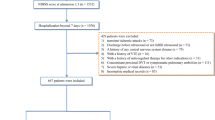Abstract
To increase the detection rate of deep vein thrombosis (DVT) and to compare the predictive value of four different risk assessment scales (Caprini, Autar, Pauda, and Khorana scales) for DVT in patients with solid tumors by the receiver operating curve (ROC). A total of 361 patients with all kinds of malignant solid tumors, who accepted anti-tumor therapy in the cancer center between March 3, 2015 to April 13, 2018, were assigned to a group of 230 cases diagnosed with DVT and a control group of 131 cases without DVT. Data were recorded and summarized, and the predictive value of the above four risk assessment scales for DVT in solid tumor patients was compared based on the area under the ROC curve (AUC). The AUC values determined for the Caprini, Autar, Pauda, and Khorana scales were (0.631 ± 0.030), (0.686 ± 0.028), (0.654 ± 0.029), and (0.599 ± 0.032), respectively; maximum sensitivity, specificity, and Youden index were 80.9% for Khorana, 86.3% for Caprini, and 29.6% for Autar scale, respectively. We found no statistically significant differences in the AUC values between Autar and Caprini, Autar and Khorana, as well as Khorana and Pauda (p > 0.05). However, the AUC differences between Autar and Pauda, Caprini and Khorana, as well as Caprini and Pauda were statistically significant (p < 0.05). All four risk assessment models showed some value in the risk prediction of DVT in patients with solid tumors, but every model also exhibited its own restrictions; maximum sensitivity, specificity, and Youden index were 80.9% for Khorana, 86.3% for Caprini, and 29.6% for Autar scale, respectively. We confirmed that the detection rate can be improved by modifying the BMI cut-off value of the scale or by combining appropriate scales.

Similar content being viewed by others
References
Fowkes FJI, Price JF, Fowkes FGR (2003) Incidence of diagnosed deep vein thrombosis in the general population: Systematic review. Eur J Vasc Endovasc Surg 25(1):1–5
Kyrle P, Eichinger S (2005) Deep vein thrombosis. Lancet 365:1163–1174
Khorana AA (2010) Venous thromboembolism and prognosis in cancer. Thromb Res 125(6):490–493
Riess H, Habbel P, Juhling A (2016) Primary prevention and treatment of venous thromboembolic events in patients with gastrointestinal cancer. World J Gastrointest Oncol 8(3):258–270
Di Nisio M et al (2011) Arterial thrombosis in ambulatory cancer patients treated with chemotherapy. Thromb Res 127(4):382–383
Falanga A, Marchetti M, Vignoli A (2013) Coagulation and cancer: biological and clinical aspects. J Thromb Haemost 11(2):223–233
Timp JF et al (2013) Epidemiology of cancer-associated venous thrombosis. Blood 122(10):1712–1723
Hisada Y, Mackman N (2017) Cancer-associated pathways and biomarkers of venous thrombosis. Blood 130(13):1499–1506
Ay C, Pabinger I, Cohen AA (2016) Cancer-associated venous thromboembolism: Burden, mechanisms, and management. Thromb Haemost 117:219–230
Falanga A, Marchetti M, Russo L (2015) The mechanisms of cancer-associated thrombosis. Thromb Haemost 135:S8–S11
Autar R (2003) The management of deep vein thrombosis: the Autar DVT risk assessment scale re-visited. J Orthop Nurs 7(3):114–124
Khorana AA et al (2008) Development and validation of a predictive model for chemotherapy-associated thrombosis. Blood 111(10):4902–4907
Verso M et al (2012) A modified Khorana risk assessment score for venous thromboembolism in cancer patients receiving chemotherapy: the Protecht score. Intern Emerg Med 7(3):291–292
Bahl V et al (2010) A validation study of a retrospective venous thromboembolism risk scoring method. Ann Surg 251(2):344–350
Barbar S et al (2010) A risk assessment model for the identification of hospitalized medical patients at risk for venous thromboembolism: the Pauda Prediction Score. J Thromb Haemost 8(11):2450–2457
Salazar AJ et al (2017) Predictors of active cancer thromboembolic outcomes: mortality associated with calf deep vein thrombosis. Int Angiol 36(6):553–557
Dentali F et al (2017) Clinical course of isolated distal deep vein thrombosis in patients with active cancer: a multicenter cohort study. J Thromb Haemost 15(9):1757–1763
Sgouros J, Maraveyas A (2008) Excess premature (3-month) mortality in advanced pancreatic cancer could be related to fatal vascular thromboembolic events. A hypothesis based on a systematic review of phase III chemotherapy studies in advanced pancreatic cancer. Acta Oncol 47(3):337–346
Elewa H, Elrefai R, Barnes GD (2016) Cancer-associated venous thromboembolism. Curr Treatment Opt Cardiovasc Med 18(4):23
Falz AS, Khan I, Beckman MG et al (2015) Characteristics and risk factors of cancer associated venous thromboembolism. Thromb Res 136(3):535–541
Kline JA et al (2015) Emergency evaluation for pulmonary embol-ism, part 1: clinical factors that increase risk. J Emerg Med 49(1):104–117
Le Gal G et al (2006) Prediction of pulmonary embolism in the emergency department: the revised Geneva score. Ann Intern Med 144(3):165–171
Nolan L et al (2011) The incidence of symptomatic thromboembolism in patients receiving adjuvant anthracycline-based chemotherapy for early stage breast cancer. The Breast 20(2):151–154
Cavo M et al (2002) Deep-vein thrombosis in patients with multiple myeloma receiving first-line thalidomide-dexamethasone therapy. Blood 100(6):2272–2273
Mukai M, Oka T (2018) Mechanism and management of cancer-associated thrombosis. J Cardiol 72:89–93
Khalil J et al (2015) Venous thromboembolism in cancer patients: an underestimated major health problem. World J Surg Oncol 13(1):204
Funding
This study was funded by the Research Project of Hubei Provincial Science and Technology Department (2018CFC846); Henry csco-Cancer Research Fund (Y-HR2017-033); Henry research Fund for hepatobiliary and pancreatic malignancies of Chen ** foundation for the development of Science and Technology of Hubei Province.
Author information
Authors and Affiliations
Corresponding authors
Ethics declarations
Conflict of interest
The authors declare that they have no conflict of interest.
Ethical approval
All procedures performed in studies involving human participants were in accordance with the ethical standards of the institutional and/or national research committee and with the 1964 Helsinki Declaration and its later amendments or comparable ethical standards.
Informed consent
Informed consent was obtained from all individual participants included in the study.
Additional information
Publisher’s Note
Springer Nature remains neutral with regard to jurisdictional claims in published maps and institutional affiliations.
Rights and permissions
About this article
Cite this article
Wang, Mm., Qin, Xj., He, Xx. et al. Comparison and screening of different risk assessment models for deep vein thrombosis in patients with solid tumors. J Thromb Thrombolysis 48, 292–298 (2019). https://doi.org/10.1007/s11239-019-01840-x
Published:
Issue Date:
DOI: https://doi.org/10.1007/s11239-019-01840-x




